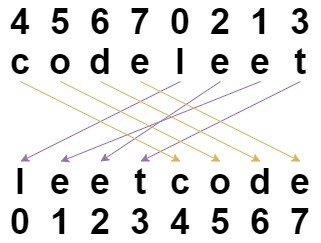- {x}
- Maximum Number of Non-Overlapping Substrings
- Find a Value of a Mysterious Function Closest to Target
- Diameter of N-Ary Tree
- Count Odd Numbers in an Interval Range
- Number of Sub-arrays With Odd Sum
- Number of Good Ways to Split a String
- Minimum Number of Increments on Subarrays to Form a Target Array
- Patients With a Condition
- Shuffle String
- Minimum Suffix Flips
- Number of Good Leaf Nodes Pairs
- String Compression II
- The Most Recent Three Orders
- Find the Index of the Large Integer
- Count Good Triplets
- Find the Winner of an Array Game
- Minimum Swaps to Arrange a Binary Grid
- Read More...

Shuffle String
You are given a string s and an integer array indices of the same length. The string s will be shuffled such that the character at the ith position moves to indices[i] in the shuffled string.
Return the shuffled string.
Example 1:

Input: s = "codeleet", indices = [4,5,6,7,0,2,1,3]
Output: "leetcode"
Explanation: As shown, "codeleet" becomes "leetcode" after shuffling.
Example 2:
Input: s = "abc", indices = [0,1,2]
Output: "abc"
Explanation: After shuffling, each character remains in its position.
Constraints:
s.length == indices.length == n1 <= n <= 100sconsists of only lowercase English letters.0 <= indices[i] < n- All values of
indicesare unique.
Solution Explanation
The problem asks to shuffle a string s according to the permutation given in the indices array. The character at index i in s should move to the index indices[i] in the shuffled string.
The solution uses a simple approach: create a new array (or string) of the same size as the input string, and then populate it according to the indices array. The character at index i in the input string s is placed at index indices[i] in the output array. Finally, the output array is converted back to a string.
Time Complexity Analysis
The solution iterates through the input string once to populate the output array. This gives a time complexity of O(N), where N is the length of the input string. The conversion from the array back to a string in most implementations (like Python's ''.join() or Java's String.valueOf()) also takes O(N) time. Therefore, the overall time complexity is O(N).
Space Complexity Analysis
The solution creates a new array (or string) of size N to store the shuffled string. This means the space complexity is O(N). In-place shuffling is not possible because we need to preserve the original string.
Code Explanation (Python)
The Python code efficiently implements this approach:
class Solution:
def restoreString(self, s: str, indices: List[int]) -> str:
ans = [0] * len(s) # Create an array of the same size as s, initialized with 0s.
for i, c in enumerate(s): # Iterate through s with index i and character c
ans[indices[i]] = c # Place character c at the index specified by indices[i]
return ''.join(ans) # Convert the array to a stringThe code iterates through the input string s using enumerate to get both the index i and the character c. It then places the character c at the index indices[i] in the ans array. Finally, it joins the elements of the ans array to form a string, which is the shuffled string.
The other language implementations follow the same logic, only differing slightly in syntax. They all achieve the same O(N) time and space complexity.